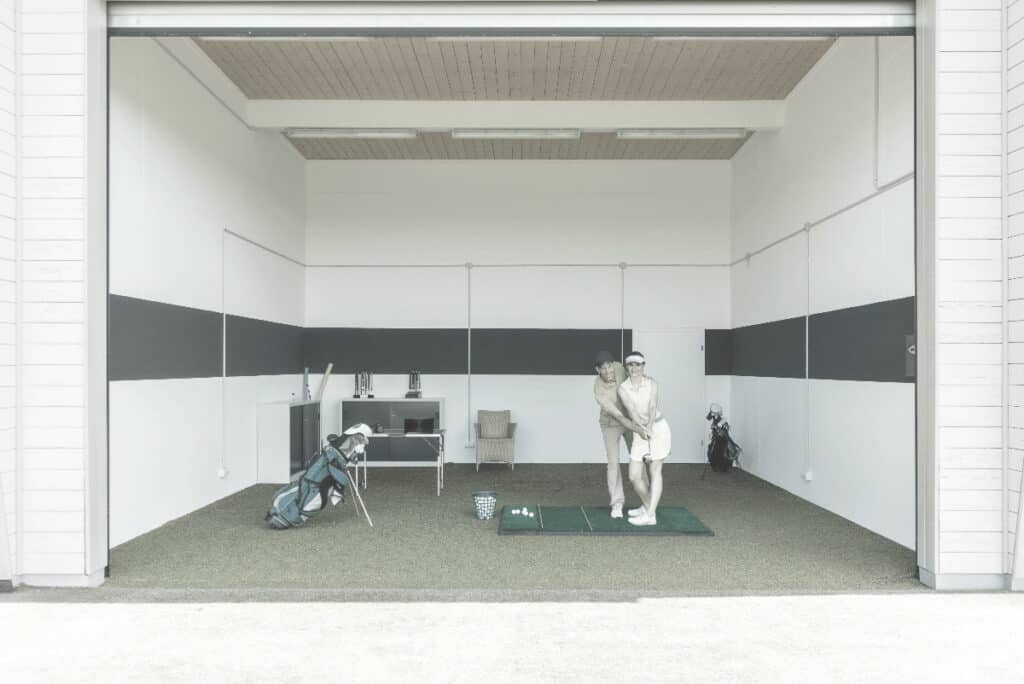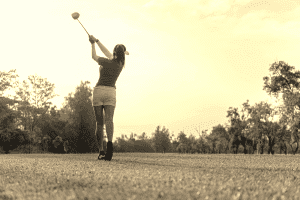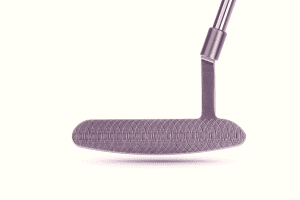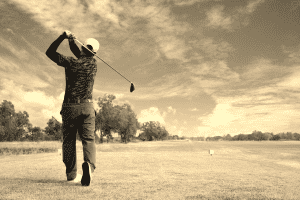Where the feet point, the golf club will follow. Simple enough? But where you think you are pointing and where you are actually pointing may not be the same thing.
Alignment in golf is one of those fundamentals that everyone should be able to get right, no matter the quality of your swing. Of course, it’s easier said than done, which is why golf alignment sticks are such a useful training aid to have in your bag. Bright, easy to see, and straight, just what you need to get your alignment, and therefore your swing, along the right path. We will take a deep dive into using alignment sticks, as well as some of the best alignment sticks on the market. Check out our full guide below!
Golf Alignment Sticks | Everything You Need to Know

What are Golf Alignment Sticks?
Back in the day, you’d place your feet ‘in about the right position’ and then proceed to bend down and place whatever club you had in your hand along the edges of your toes before stepping back to assess whether you’d ‘guessed’ your alignment correctly.
In reality, if you’re training for alignment without a visual aid to help you, you’re incredibly likely to make a mistake, and even worse train your body to feel the wrong alignment. Golf alignment sticks do away with the guesswork.
Alignment sticks are normally a thin, lightweight, and brightly colored pair of straight edges that you can use in many different ways. They act as a framework around which you can form your swing, stance, and alignment.
They are usually made of a durable material like fiberglass, meaning that they can take a little punishment, whether that is being hit with a stray swing or stepped on. (try doing that with your brand new Sim Max 2 Driver shaft, you’ll end up heart broken)
What to Look for in Alignment Sticks for Golf?
Price
Ok, here’s a prime piece of advice for anyone looking to buy some golf alignment sticks…
They don’t need to be expensive. While a lot of golf technology is packed full of little ‘extras’ that may help you get the edge, alignment sticks don’t benefit from additional cost. A cheap pair of golf alignment sticks should perform just as well as a premium set.
They are a golf training aid, and a means to an end. If they work well, you will be looking at using them less often as time goes on.
Durability
Even with the best of intentions, golf alignment sticks have to be able to withstand quite a lot of rough treatment. As you’ll see below, many of the exercises that we will suggest put your sticks in mortal danger of being hit, whacked, and trodden on.
Obviously, the potential exists for breakages, but there is something else to consider… It could be even worse than a breakage?
Even worse? How?
You definitely don’t want alignment sticks that take on a bend. Remember, they are designed to straighten up various planes surrounding your swing geometry. Lines for golf training need to be straight, not curved, and variable.
Visuals
Let’s just come right out and say it. Don’t buy a set of dark green golf alignment sticks. To get the maximum benefit, you will want sticks that stand out and are easy to see. Anything that is a sharp contrast to the surrounding fairway or grass is a great choice.
When it comes to visuals, you’ll find some models have a little extra. This could be a gradient section or a different colored central section. This saves the hassle of inserting tee pegs to mark your ‘hit zone’. It also gives you a consistent ‘datum’ depending on which exercise you perform with the sticks.
Rounded and Covered Ends
As you are about to see, there are various ways to use golf alignment sticks. Some of which involved pushing them into the (soft) ground. Can you see the problem that this might present?
A sharp stick at chest height might not be the most ‘eye-friendly thing ever. Especially if you are bending down to pick up tees or balls. Rounded ends are vital in preventing or minimizing the risk of injury.
Why You Should Use Golf Alignment Sticks?
With a pair of golf alignment sticks, you don’t have to imagine your alignment, which is something so many golfers struggle with. And that’s the point.
There’s one key concept to playing great golf. In a word? Consistency.
Golf alignment sticks allow you to gain a measure of consistency when trying to fine-tune your swing. Because you’ve gone and literally ‘drawn a line,’ you will be able to create a physical datum around which you can work.
As the saying goes, ‘if you aren’t measuring, you are guessing’… Golf alignment sticks are the opposite of this. You create a physical and highly visual ‘real world’ line that you can work from to see, feel, and hear the effects of changing your swing in real-time and consistently.
It isn’t just about alignment, either. You’ll be amazed at all of the different ways that you can use golf alignment sticks to get your swing and set up looking perfect.
Aside from using them flat on the ground in various configurations, you can also stick them into the turf to train your swing plane, dictate stance width. They even serve as a ‘gate’ through which you can hit shots.
How To Use Golf Alignment Sticks
Ok, so let us look at some drills that you can perform using golf alignment sticks. We’re going to look at a variety of different setups, from getting your stance and posture just right to some fun and dynamic drills that will really get you putting some shape on your shots
1. Simple alignment (aka ‘train tracks’)
When we first mentioned golf alignment sticks, this is probably what came to mind. This drill is designed to ensure that you know exactly where your feet, the clubface, and your swing should all be headed.
Start by placing a ball on the tee or fairway, then position a stick about 6 inches away from the ball, pointing directly at your target. Position the second stick a foot closer towards you, running parallel to the first alignment stick.
This ‘train track’ is where your ball should go, provided that you swing along the line of the stick closest to the ball.
Remember how we said golf is about consistency? While this is a simple drill, you’ve already ticked two boxes…
You’ve started to train your brain on how a ‘square’ stance and correct alignment should look. And you’ve also performed some ‘troubleshooting’. If the ball doesn’t go where the tracks are pointing, then there’s a good chance that either your swing or the clubface is not aligned.
Now you know the problem, you can start thinking about how to rectify it. Here’s a great video that demonstrates this technique
2. Hitting a Draw
By making a slight adjustment to the ‘train track’ method, you can easily learn to shape your shots. We all want to know how to hit a draw.
Here’s how to do it using a set of golf alignment sticks:
A draw relies on two elements that come into play at once. First, the clubface needs to be in the right place at impact, and secondly, the swing won’t follow a square plane but an in-to-out path.
To do this using alignment sticks, leave your standard ‘train track’ line closest to the ball pointing at the target. Move the end of the stick closest to your feet so that the train tracks converge slightly going towards the hole.
Then address the ball with your feet along the nearer ‘track’ and the clubface square to the target line.
Notice anything? You are in a slightly closed stance. As we said right at the beginning, the clubhead should follow where your feet are pointing, so, relative to where the clubface is pointing, you will create an in to out swing path and impart spin on the ball that encourages a draw.
3. Hitting a Fade
This is essentially the opposite of the above. Instead of creating a slightly closed stance, we can move the stick closest to our feet with the face square to the target line, making an open stance.
We leave the clubface and stick nearest the ball, pointing straight at the target. From there, it is just a case of how we position our feet. In this case, we want our feet to aim slightly to the left of the target line. Otherwise known as… an open stance.
By creating an open stance and being able to consistently fine-tune what is ‘too open’ or ‘just right’, we create an out to in swing path that will impart just a little clockwise spin on the ball, making it start straight and then gradually move right.
4. Hip Rotation
Getting your shoulders and hips turning is vital to getting distance. But it takes practice. While you are moving, it is really difficult to keep an eye on what different parts of your body are doing (it pays not to think too much about them during your natural swing).
Hip rotation is important for increasing distance. There’s a fair few big muscles around your core that all contribute to generating real clubhead speed.
There is an easy way you can see how much your hips are turning (or not) during the swing by using golf alignment sticks.
Simple insert a single alignment stick through your belt loops and take a few light swings. Does that stick stay pointed where it is? If so, you probably aren’t turning your hips enough. If it draws a wide arc, you know that you are getting a decent rotation of your hips during the swing.
Here’s a great video demonstrating the above principle.
(Disclaimer: remember to remove the stick before heading off to the 19th)
5. Correcting your Swing Plane
A great swing starts from the moment the club makes its way backward. Let me ask you a question…
When you take the club back, is your swing plane too steep?
Don’t know?
Don’t worry. Most golfers don’t, but using a couple of golf alignment sticks will let you see in seconds. This isn’t the most conventional way to use golf sticks, but it shows how dynamic they can be.
A stick is inserted into the ground and pointed towards you at an angle exactly the same as your club shaft at address. The ball is played from a few inches closer to you. You’ll find that if your swing is too steep, you will need to maneuver your hands to hit the ball at all.
Want to see it?
Check this video out to see how to set it up…
6. Ball Position
Where you position the ball in your stance can be a little ‘make or break’. Get it wrong, and the entire mechanics of your swing can change to compensate. Over time this can lead to really bad habits developing that start to feel ‘normal’.
Alignment sticks will allow you to create a baseline and be confident that when that ball is supposed to be positioned inside your left heel that it actually is.
There’s no magic to this. Just place two golf alignment sticks at a right angle with the ball positioned where they intersect. You now have a really neat visual representation of where ‘back’, ‘center’, and ‘forward’ are in your stance.
Here’s what it looks like:
7. Club Path
Where your feet are pointing is only half the battle. Where the clubhead actually goes is what influences the flight of the ball. If you have started to notice a ‘shape’ to your shots and your feet are pointing at the target, maybe the club path isn’t going where you think it is.
Alignment sticks are a great way to create a repeatable and consistent swing path. Essentially you can create a narrow ‘channel’, with the ball between the two sticks, that the clubhead must cut between to hit straighter shots.
Start with the sticks fairly wide, and as you get more consistent, make your ‘channel’ narrower. This is a great way to train accuracy in hitting the ball from the club’s center!
Here’s an example:
8. Tunnel Drill
Even gone to the driving range and crushed every shot, only to be on the course a half-hour later and find your accuracy has disappeared?
Here’s the thing… It didn’t. It was never there, to begin with. Driving ranges are wide… Courses are narrow. You need a reliable way to focus your accuracy.
Well, you can recreate this demand with a couple of alignment sticks.
Just position the sticks a couple of yards ahead of you and about a yard apart. The aim is to hit your shots through this gate.
Aside from being slightly more fun than just smashing balls, you can give yourself a real metric to gauge improvement.
How so?
I like to hit 30 balls as a warmup routine before each round using this drill. Count how many go through the gate and how many miss. After a week of this drill (and a little practice), you’ll probably find that your accuracy has improved.
Picking your way out of trouble? Easy.
Best Golf Alignment Sticks
So, you like the idea of improving your game and giving yourself a ‘real life’ means to observe your swing mechanics and performance?
That’s great.
But you want sticks that will work and take into account all of the things we said to look for above.
Here are a few suggestions for the best golf alignment sticks on the market:
Callaway ALIGNMENT STIX

Ideally, you want your alignment sticks to be on the long side. This provides you with plenty of scope to use them in a variety of ways. The downside is that they can be a little cumbersome to carry in a golf bag, especially if you intend to do a little practice out on the course.
Callaway has come up with a solution. These golf alignment sticks are adjustable and foldable, meaning they are easy to stow in your bag, trunk, or even a locker at the club. They are rounded at the ends, and you can even create 90° shapes and boxes, perfect for different exercises. These are affordable, practical, and get the job done.
Champkey 48″ PRO Golf Alignment Sticks

Remember how we talked about bright colors and rounded ends? Here’s a great example. At 4 feet, these golf alignment sticks will allow you to practice all of the drills mentioned above and more. They have one plastic pointed end making it easy to insert the sticks into the ground. The other end is topped with a rubber safety cap.
The sticks are constructed using fiberglass, which is flexible and durable, so they should last a long time for a one-off investment.
Oh, and I should mention that there are three in a pack. This is great as it lets you combine a couple of training drills at once. Want to fine-tune your alignment and calibrate your swing plane? You can do both!
Pro-Stix Alignment Poles

As budget options go, these are pretty great. As with the sticks above, you’ll get four feet of bright orange fiberglass to create lines and paths to hone your swing. One thing I really like is the white gradient indicating where the center of each stick is located. This is great for creating consistency in placement, particularly when working out where the ball is positioned in your stance.
FAQ
Have you still got questions about golf alignment sticks? Here are some of the things that are commonly asked.
Do Golf Alignment Sticks Work?
Yes, golf alignment sticks do work. Some of the drills to perform with alignment sticks have actually been around long before they were invented. The alignment sticks just make it easier and avoid the risk of getting your grips dirty by placing your new TaylorMade P790 irons on the floor.
Golf alignment sticks allow you to perform goal-oriented practice. Take, for instance, our ‘tunnel’ drill above… By measuring your progress, you can see whether you are improving, and if not, take steps to rectify problems. Golf alignment sticks give instant physical feedback, which is ideal for learning.
How Long are Golf Alignment Sticks?
This depends on which model you choose. The standard length for a set of ‘stock’ golf training sticks is around 4 feet. As you’ll have seen with our suggestions above, folding, more portable versions can fold down to ¼ of the size!
How Do I Make Golf Alignment Sticks?
Listen, gone are the days of putting a driver on the ground or placing tee pegs in a line to assess a swing path. Neither is accurate or what the equipment was intended for. Bearing in mind the price, for the money, a set of golf sticks is a cheap way to take shots off your game and see tangible results in your practice.
You could try with string, chalk, or water-based paint, but how sure can you be that those lines will be straight? If it sounds like a hassle, that is because it is. We’d advise buying a set of sticks instead of looking like a city planner while out on the course.
How Many Golf Alignment Sticks Do You Need?
As an absolute minimum, we’d recommend two. That will be enough to perform a wide variety of drills. For a little extra flexibility and the means to work on two areas at once, a set of three golf alignment sticks might be the better option.
Final Thoughts
Sometimes the simplest solutions are the best. There isn’t too much that is hi-tech about golf alignment sticks. However, you are limited in your practice opportunities only by your own imagination. They are one of those things that you didn’t know you were missing until you picked up a set and found that your game improved. How much is each saved golf shot worth to you? For the money, these golf training aids give you a significant return on your investment. Thanks for reading.









